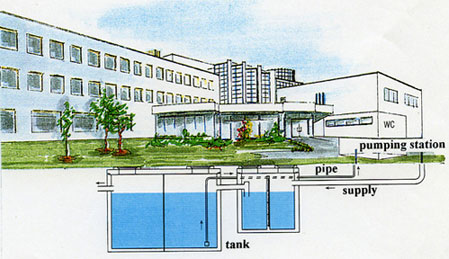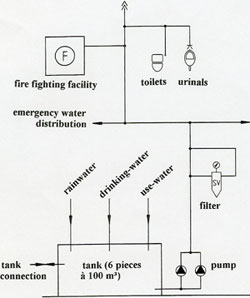Rooftop water collection systems:
1. Changi Airport: Changi Airport system collects and treats rainwater, which accounts for 28 to 33% of its total water used, resulting in savings of approximately S$ 390,000 per annum. The potential for using these rooftops as catchments are high. The system developed have been result of intensive research. A simple computer programme was developed and nomogram prepared relating the roof area, tank size and roofwater available.

2. High Rise Buildings: In this system implemented in a 15 storey building, the collected roofwater was diverted to two rainwater tanks and the water was used only for flushing. The water quality was acceptable in terms of color, turbidity and bacterological content though the total solids and chloride levels were marginally higher. A simple dual mode system was incorporated in the collection tanks which were placed on the roof of the building. An economic appraisal established that there was an effective saving of 13.7% of the water. The cost of the rainwater was s$0.395 (us$0.25) per cubic meter (cum) as against the cost of potable water which was s$0.535 (us$ 0.33).
 3. Urban Residential Area: In an urban residential area of about 742 hectares having a total of 49,000 flats, rainwater harvesting was very effective. Using further modified computer programme, it was possible to compute the volume of potable water to be pumped when there was no stored rainwater and also determine the frequency of such pumping.
3. Urban Residential Area: In an urban residential area of about 742 hectares having a total of 49,000 flats, rainwater harvesting was very effective. Using further modified computer programme, it was possible to compute the volume of potable water to be pumped when there was no stored rainwater and also determine the frequency of such pumping. 4. Capturing Urban Runoff: By 1986, the growing need for water led to the establishment of the lower Seletar-Bedok water scheme where almost nine per cent of the total land area was used. The most important feature of this scheme is that almost one-quarter of this catchment is in urban area having high rise buidings and industries and surface run-offs were subject to a wide varities of contaminants. Hence the control of the water pollution and relevant technologies were the main priorities of the scheme. The lower involved the damming of the Sungei Seletar estuary, which has a catchment area of 3200 ha, and forming of lower Seletar reservoir. The reservoirs are interconnected and raw water from Bedok reservoir is treated to potable levels before distribution. The rest of the catchment of 2,625 ha was primarily urban and both the runoffs are directed to Bedok reservoir. http://www.rainwaterharvesting.org/international/singapore.htm